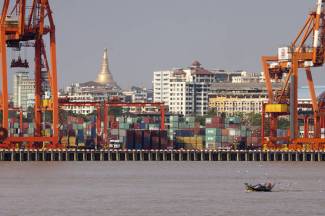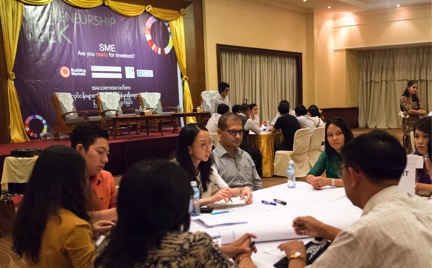Compliance and Registration of Myanmar SMEs

It is no secret that the growth and development of Myanmar SMEs constitutes a necessary condition for the country’s overall economic reform. That being the case, it is encouraging that there are already at least 126,000 SMEs in Myanmar, constituting over 99% of domestic firms. However, it is also the case that many enterprises in Myanmar (Over 80% by some estimates) operate informally, albeit for understandable reasons.
The operating environment for SMEs here is of course notoriously difficult, with entrepreneurs having to overcome daunting obstacles including lack of infrastructure, almost no access to financing, and a dearth of government service oriented toward SMEs. So it is entirely to be expected that a small business owner in Myanmar today would ask “Why should I register?” when doing so has historically only meant additional costs for that person’s business, including payment of taxes.
While acknowledging all of this, it is also plain that conditions are rapidly changing for Myanmar entrepreneurs. Opportunities for growth and profits are rapidly springing up in heretofore unexpected areas, while in areas that would have been considered safe bets but a few years ago, risks and competition are multiplying. It is highly likely, however, that in order to mitigate these risks and take advantage of these opportunities, firms are going to need to register themselves with the government in accordance with the law. In fast, a 2013 OECD report stated that the transition of labor and other assets into the formal arena will be and important part of Myanmar’s development.
A Changing Myanmar Business Environment

It has been said in many other places that the coming of the ASEAN Economic Community (AEC) will drastically change Myanmar business environment, even for SMEs in Myanmar. Despite the temptations and inertia to do so, entrepreneurs can no longer afford to think of themselves as only operating at a local level. Even small operations are already facing the pressures of a globalized economy, and there is concern among many economists that Myanmar SMEs are not prepared to handle this new reality. Various tariff schedules will continue to disappear, further stiffening the competition that Myanmar enterprises will face from foreign companies.
This is particularly the case in sectors such as household products, consumer electronics, canned goods, snack foods, plastic products, and many other areas. In most of not all cases, these foreign firms take favorable regulatory environments in their home countries, benefits that they enjoy as legally recognized enterprises in those countries. If they are to be competitive, the Myanmar government and the enterprises are going to need to develop similar cooperative relationships.
However, good businessmen often see opportunity where others see only risks. There is no reason why a Myanmar entrepreneur cannot turn the tables and take advantage of the opportunities that AEC will create, such as the opportunity to tap regional and international market potential. As is well known, there are many enterprises in Myanmar that have this potential due to Myanmar’s geography, situated as it is at the crossroads of India, China, and the rest of South East Asia. Taking advantage of this, however, will require entrepreneurs to develop ties with counterparts, both within Myanmar and abroad. This is new and larger networks will need to be developed that can give the entrepreneur market intelligence and information. A prerequisite for doing all of this, however, will be to first become a legally recognized enterprise.
The changing business environment may be seen as positive in other ways. Foreign companies are coming to Myanmar not only or even primarily to complete with Myanmar SMEs in many cases they are looking to partner with them. Sometimes, these partnerships will take the form of joint-ventures between the foreign company and Myanmar based company. We are beginning to see a lot of this in sectors like mining food and beverage manufacturing. And where joint ventures are not feasible, there will still be opportunities to supply these incoming enterprises. Either way, taking advantage of such opportunities is going to require registration.
So the way in which the business environment in changing entails that enterprises will need to register and comply in order to both mitigate the risks, and take advantage of the opportunities. The new environment also entails that the Myanmar government is going to have to make a lot of changes on its end in order to provide a more friendly business environment. Given recent history, business owners can be forgiven a certain amount skepticism with regard to this, but even so, the evidence is that needed changes are in fact happening.
A Different Kind of Regulatory Regime

The bottom line is that in order for a Myanmar entrepreneur to feel that it is really worth his while to register his business, he will need to be convinced that there is something he will get in return. Historically, such incentives have been almost entirely absent, and one of the challenges of the economic reform process has been getting government officials to see that such incentives are essential. These efforts are beginning to bear fruit, and now Myanmar is slowly but surely moving away from a legislative framework that aims only at regulation and control, to one which also aims at business promotion and development.
However, claiming the benefits that are the immediate results of these changes, and taking advantage of the favorable environment that is slowly beginning to emerge as result both require that one operate one’s business within the confines of the law.
There are at least three concrete examples of how the Myanmar government is moving to create a better business environment. Beginning with the obvious, in 2013 the Myanmar Central Committee for SMEs development was created. Granted, the Committee’s basic function is to coordinate SMEs policy among various line ministries, and so it does not have the robust powers of a full statutory board like SPRING Singapore. Still, it institutions will take some time to evolve. That having been said, the hope is that in a few years the government will have give a semi-autonomous SME board the power to actively nurture startups, link Business Development enterprises, and provide financing to businesses.
As is well known, the government is also moving quickly to establish Special Economic Zones (SEZs), as well as to expand industrial development zones. These are but the most obvious examples of hard infrastructure improvement which will benefit SMEs (especially in the agricultural products sector) in general. Granted, many SMEs may not directly benefits in the form of supply opportunities will be significant. On the SOFT infrastructure side, few will doubt that the rapidly expanding telecoms network will benefit small businesses, will beneficial results multiplying as e-commerce platforms come on line. All of this has been made possible by the government’s comparative willingness to issue tenders in a way which is both transparent, and in line with international best practices.
The third example of actions taken by the Myanmar government to improve the business environment has to do with public-private consultations. Recently, and at the urging of the President, the International Finance Corporation (IFC) has partnered with UMFCCI to create the Myanmar Business Forum (MBF). The purpose of the forum is to provide the Myanmar private sector with an opportunity to help craft the laws and regulations by which it will be governed. There are in fact separate fora for each of seven different industry sectors, and each group regularly meets with government officials to provide input into the latest regulations. Note that this is something that may be participated in right now by any registered company, and IFC especially is keen to increase participation by Myanmar SMEs.
An improved regulatory environment will have several tangible results. Infrastructure improvement in general, and SEZ construction in particular will better enable SMEs to take advantage of economies of scale. This means that firms will be able to grow their operations while at the same time increasing efficiency and competitiveness. However, growing a firm in this way will certainly require regulatory compliance. Effective development of such infrastructure is also likely to support cluster development, if efforts can be made to link larger companies working in the Zones and Estates to smaller, local suppliers.
But perhaps the most important and hoped for result of an improved business environment is better access to financing. While most Myanmar SMEs will not be able to take advantage of the recent entry of foreign banks into the country, their arrival here should be seen as a positive step. As a stop gap measure until the arrival of formal banking services, SMEs in Myanmar have access to the Small and Medium Industrial Development Bank (SMIDB), which announced last November that it will be able to provide loans to SMEs at an interest rate between 6 and 8.5%. Both JICA and IFC have begun similar projects to help increase funding for SMEs. Needless to say, however, access to financing may only be had by a legally registered entity with good and transparent accounting, auditing and governance practices.
Finally, it is worth noting that as the government builds its capacity regarding services and promotion for businesses, it will also be building its capacity with respect to tax collection. Indeed, the Government is increasingly widening its tax net and in due course will introduce a Value-Added Tax (VAT), as this has proven to be a source of much greater tax income than an income tax on profits. All SMEs will be included in that system and will need to comply if they want to engage in trade and commerce within the complying community. So it is best to prepare for compliance and reduce the risk of exclusion as well as potentially major tax assessments and penalties.
If economic reform in Myanmar proves successful, one of the things that will mean is that not registering a business may in fact entail more risks and less access to opportunities than would be the case if one registers. Again, the government’s actions and policies over the next few years will largely determine whether the previous statement proves true or false. But it is also clear that thus far, significant progress has been made. While there will always be competing interests and problems getting one side to understand the other, the relation between the government and the private sector should begin to move from being one of a cat and mouse game between business owners and regulators to one that is more of a collaborative relationship. For sure, the onus is mostly upon the Myanmar government to change its approach and mindset. Business leaders are almost certain to catch on faster to the new order that is coming. However, that catching on will almost certainly require operating within the law, as a fully registered and licensed business establishment.


 Myanmar’s industrial development was in the process of implementation since the previous government under the ambitious plan known as “Myanmar to be a Modern, Developed Industrialized Country”. A 20 years-long Myanmar industrial development plan, split into four different 5 years plan, is currently being created to enhance the development of the industrial sector. Under the first 5 years plan, the primary issue is the development of
Myanmar’s industrial development was in the process of implementation since the previous government under the ambitious plan known as “Myanmar to be a Modern, Developed Industrialized Country”. A 20 years-long Myanmar industrial development plan, split into four different 5 years plan, is currently being created to enhance the development of the industrial sector. Under the first 5 years plan, the primary issue is the development of 




